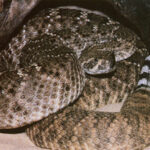A snake’s skin is a fascinating thing. Is made up of two parts, each with multiple functions. The first part is the interstitial skin. This is the thin, stretchable part of the skin that is covered by the scales in most snake species. This part of the snakes skin allows the snake to expand its girth when swallowing its prey. The scales are the second part of the snake’s skin. The scales of the snake perform many functions.
One of the primary functions of a snakes scales is to protect the snake from hurting itself as it slithers across rough terrain. It also provides protection against predators as well as the prey that it attacks and eats.
In desert species, scales help to prevent the snake from becoming overly dehydrated.
Scales also help to pull the snake along the ground. When a snake raises up off the ground, it is using its scales.
There are many different types of scales. Each type of scale has a function, and all are important to the snake.
The scales that are found along the top of the snake and down the sides is called the dorsal scales. These may be rough, or they may be smoothed. This is determined by the snake species and its individual needs. For example, a burrowing snake will have smoother scales to aid it in digging through the dirt.
Underneath the snake, the scales are called ventral scales. These scales on the underside of the snake are generally smoother than the scales on top. This allows for better movement of the snake across the ground.
Another type of scale found on snakes is the head scale. This scale varies wildly from species to species. Some snakes have very large head scales while others have scales that are very small.
The color of different scales cover every color in the rainbow. The positions of these colored scales give the snake its patterns. When you look at a colorful snake it is actually many different individual scales, each with its own unique color. The different colors that you find among snakes is due to the varying needs of the species. Some snakes are colored so that they are completely camouflaged in their habitat. This aids in hiding from predators as well as ambushing prey themselves.
The rattlesnake is one of the most fascinating snakes on the planet. It has modified scales on the tip of its tail that stay in place when it sheds its skin. These leftover scales form the infamous rattle that it uses to warn off danger. What an amazing adaptation of nature these reptiles are!




